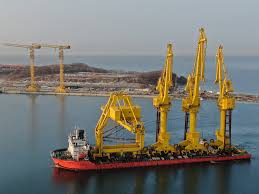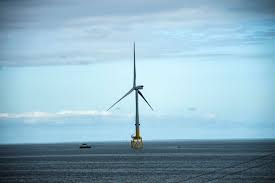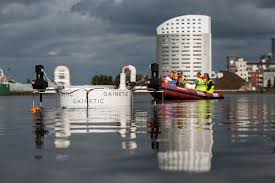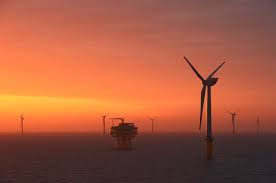Zvezda cuts steel for 3rd LNG-powered MR product carrier
Russian Shipbuilding Complex Zvezda has cut steel for the third MR-type product carrier operating on LNG as marine fuel ordered by the compatriot shipping major Sovcomflot in 2019. The 1B-ice class tanker will have a deadweight of about 50,000 tonnes, length of over 180 meters, width of over 32 meters and a draft of 13 meters. The ships will be capable of conducting year-round navigation, including in the ice conditions of the Baltic Sea. The LNG- powered MRs will be used to transport oil products and gas condensate under a long-term charter to a unit of PAO Novatek. Sovcomflot has been supporting the switch to LNG as a marine fuel as part of the industry’s decarbonization efforts for a while now, and the company already operates a series of Aframax-class tankers that run on LNG as fuel. Zvezda Shipbuilding is being created on the basis of the Zvezda Far Eastern Shipyard by a consortium of Rosneftegaz, Rosneft and Gazprombank. The complex is planned to be able to construct large capacity ships designated for servicing offshore mineral production projects, including in the Arctic, and also merchant ships that will transport cargo on national and international waterways.
(Credits: www.offshore-energy.biz)

Equinor to test floating solar pilot in rough waters of Norway
1617874935.jpg)
Norwegian energy major Equinor, in collaboration with Saipem company Moss Maritime, plans to build and test a pilot floating solar plant off Frøya in Norway in the late summer of 2021. The project is set to become the world’s first pilot plant for floating solar power in rough waters, according to Equinor. The company has filed an application with the Norwegian Water Resources and Energy Directorate for a plant planned to measure 80 m x 80 m, and tower less than 3 metres over the sea surface. The purpose of the pilot plant is not primarily to see how much energy it can produce, but how the weather conditions affect the plant, Equinor noted. The Norwegian coast and continental shelf are world-class when it comes to oil, gas and wind, but when it comes to sun, other regions offer better conditions. As a test area, Frøya is still very suitable. According to the plans, the pilot will be tested for minimum one year. Hanne Wigum, head of the Equinor technology unit focusing on wind and solar power, said: “The municipality of Frøya has been a good collaboration partner for us. We have reached an agreement with the grid owner, allowing the electricity that is produced to enter the power grid on Frøya. In addition, the nearness to our research centre in Trondheim, and the expertise possessed by the Sintef and NTNU research institutions,
represent an advantage for us”.
(Credits: www.offshore-energy.biz)
ScotWind offshore wind leasing round opens for applications
Crown Estate Scotland has opened the application window for the ScotWind seabed leasing round for offshore wind projects. From today, 15 January, registered developers are able to apply for seabed rights to build Scotland’s next generation of offshore wind farms. The closing date for submitting applications is 31 March. Opening the application window follows Marine Scotland’s publication of its Sectoral Marine Plan for Offshore Wind Energy outlining the areas suitable for development. Crown Estate Scotland has now made available to applicants final technical details of the application requirements, including provisions reflecting the Sectoral Marine Plan, which will enable them to make informed applications. “Today is an important milestone in the development of ScotWind Leasing, and we are looking forward to receiving applications and continuing to work with all interested groups over the coming months,” said John Robertson, Head of Energy and Infrastructure at Crown Estate Scotland.
(Credits: www.offshore-energy.biz)

GKinetic bolsters team

Irish hydrokinetic turbine developer GKinetic Energy has expanded its team further with a new hire of a mechanical design engineer, Gary Brennan. Brennan previously operated his own Architectural Technology service for 8 years specialising in draughting, surveying & certification and developing extensive experience in design, client liaison and time management. During that time, he developed an interest in renewable energy and energy conservation which eventually drove him to return to University to study Energy Systems Engineering. He completed an honours degree in Mechanical Engineering, with a minor in Energy Systems at NUI Galway. In 2015, he secured an industry placement with Smart Hydro Power in Germany, where he up-skilled on hydrokinetic systems and bathymetry, working across several roles. He even worked in Peru for some time carrying out detailed site analysis and hardware upgrades to deployed island grid systems in the Amazon Basin.
(Credits: www.offshore-energy.biz)
Trianel Windpark Borkum opens tender for CPS work

Trianel Windkraftwerk Borkum has issued a tender for subsea works on the cable protection systems (CPS) and bolt exchanges at diffusor plates at the Trianel Windpark Borkum project in Germany. The selected company will be in charge of installing 20 preventive CPS retrofits, four corrective CPS retrofits, as well as bolt exchange at six steel plates. The installation phase is limited to 30 days with the option of extension by two times per one week. The contract will start on 1 May and is planned to end on 31 December. It is set out to be a one- year contract, with the option to be prolonged for one more year – second campaign in 2022. The deadline for submitting applications for the tender is 11 February by 12:00 local time. The 200 MW Trianel Windpark Borkum comprises 40 Adwen 5 MW turbines which have been operational since 2015. The project owner recently commissioned the project’s second phase, which features 32 Senvion 6.2 M152 turbines.
(Credits: www.offshore-energy.biz)

